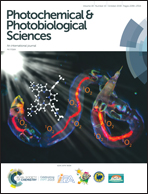Photoactivated biscarbocyanine dye with two conjugated chromophores: complexes with albumin, photochemical and phototoxic properties†
Abstract
Complexes of photosensitizers with blood proteins play an essential role in their delivery to the cell, as well as in the efficacy of photodynamic therapy. Biscarbocyanine dye non-covalently binds human serum albumin (HSA), the dissociation constant of the dye with albumin being Kd = (1.7 ± 0.1) × 10−5 M. According to time correlated single photon counting (TCSPC) fluorescence lifetime spectroscopy data, two types of complexes with lifetimes of 1.0 ns and 2.5 ns are formed between the dye and HSA. Confocal fluorescence microscopy has unambiguously shown the penetration of biscarbocyanine into endoplasmic reticulum, lysosomes, mitochondria and nuclei of the cells. The dye demonstrates photocytotoxicity towards the colon carcinoma HCT116 cells with IC50 = 0.3 μM. Hydrophobicity of the polymethine chain and the presence of two positive charges on the dye molecule contribute to the effective binding of the dye with HSA and the penetration into cells. These facts allow considering the biscarbocyanine dye as a promising agent for the photodynamic therapy of cancer.



 Please wait while we load your content...
Please wait while we load your content...